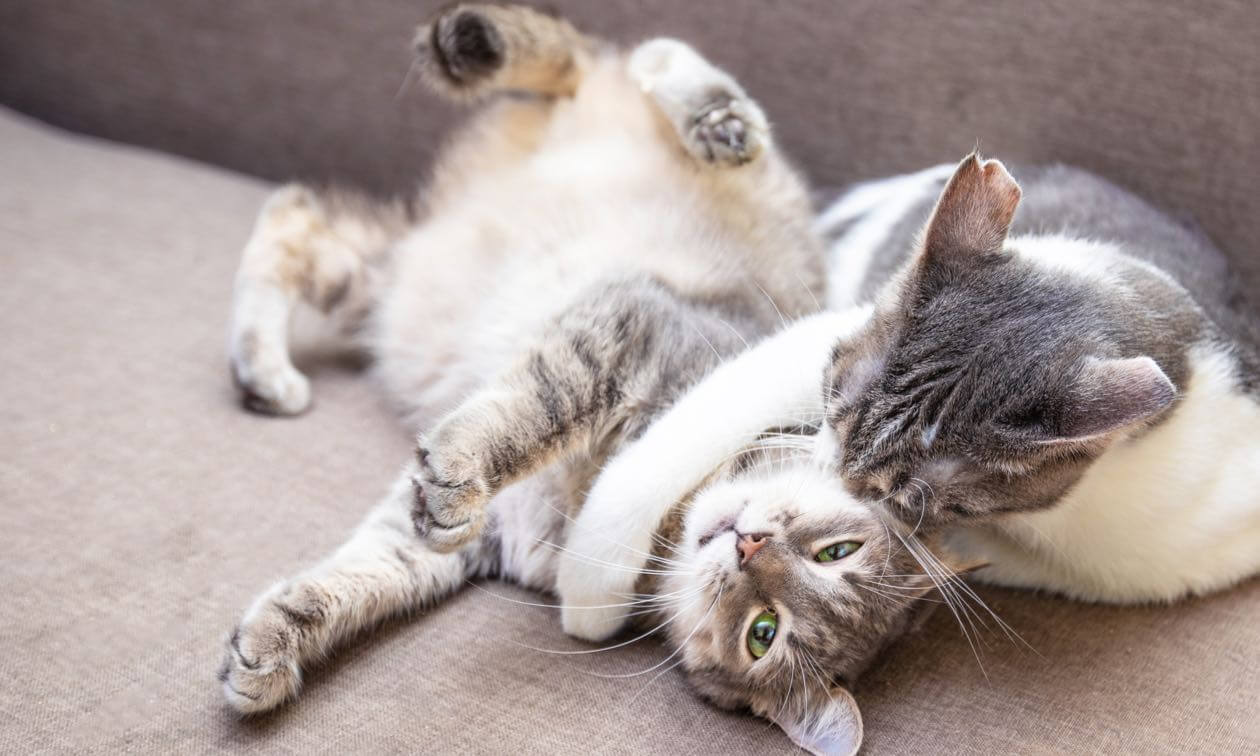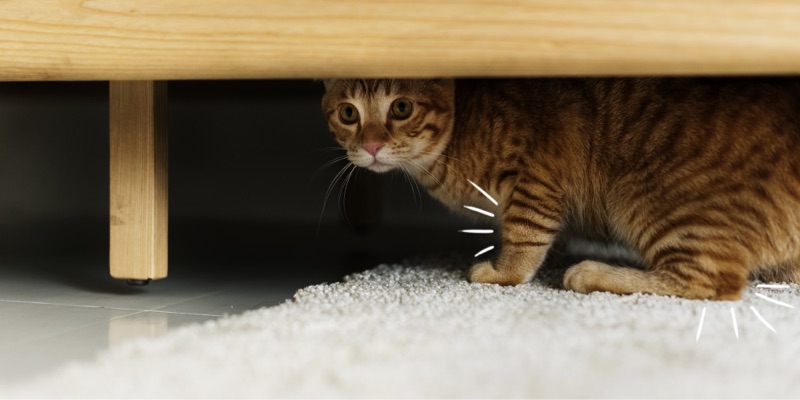You may see your cats interacting and thinking they are playing rough, but it’s important to be able to tell the difference between playing and fighting. Cats are predators, and when they play, they’re using their hunting skills (which can look intense). On the flip side, cats are also prey and often have to defend themselves in the wild. Those defensive skills come out when they’re playing as well. The result is a confusing ball of fur, claws, and teeth rolling around in ways we don’t always understand. Use these tips and tricks to figure out if your cats are fighting or playing (and what to do about it).
Signs Your Cats Are Fighting or Playing
It’s important to know when cats are having a truly negative interaction so you can determine a plan to help with the situation. While every cat is unique, here are some simple guidelines to try and figure out if they’re fighting or playing.
Body Language Before and After
- Playful: After the confrontation, both cats seem relaxed and either rest or bounce off in a carefree way.
- Aggressive: One or both cats seem unsettled, fearful, or uncomfortable. Body language may include cowering, low-level growling or hissing, swatting, hiding, or generally looking anxious.
Taking Turns
- Playful: They take turns being the “attacker.” One cat is doing more of the pouncing and biting, and then they switch.
- Aggressive: One cat is always the “attacker” in a single session, and the other cat is always trying to defend themselves. In this case, the aggressive cat may look for the other cat when the other cat is eating, sleeping, etc. and start an interaction.
Stay or Retreat
- Playful: Both cats are willing participants. If one decides to leave, the other lets them.
- Aggressive: One cat consistently tries to leave, and the other continues their “attack,” not letting them end the interaction.
Easy Distractions
- Playful: Even in the most intense moments, one or both cats may be easily distracted. Fight! Fight! “Oh, a butterfly.” Fight! 10-second break to lick a paw. Fight! “What was that sound?” Fight!
- Aggressive: Both cats are intensely focused on each other and can’t be easily distracted. There will not be many breaks.
Vocalizing
- Playful: There are exceptions, but in most cases, play fights don’t involve much vocalizing.
- Aggressive: It’s common for one or both cats to hiss, growl, and/or yowl.
Why You Should Interrupt Cat Fights
Cat fights are upsetting (not just for, you but for your cats). Even a few swats, intense staring, or a quick pounce can damage your cats’ relationship with each other and their overall stress levels. This can lead to many unwanted outcomes, including:
- Increased aggression between the cats
- Decreased confidence in one or both cats
- Fearful behavior toward other pets and people
- Changes in their relationship with you
- Stress behaviors such as house soiling, scratching furniture, spraying, overgrooming, hiding, etc.
If your cats aren’t getting along, it’s vital that you try and identify any triggers and improve the relationship for their mental and emotional well-being and the harmony of your home. Your veterinarian can be helpful in determining the best ways to address the fighting.
How To Stop A Cat Fight Or Negative Interaction
When cats are in a heightened state, they can easily redirect their emotional distress to you in the form of aggression. It's important to make sure you're safe at all times. It's critical for you not to try and pick the cats up or be involved in their fight.
If your cats are staring at each other or you can feel a negative interaction coming, but nothing negative has happened yet, change the mood. Get your cats to focus on something else. Grab a toy or some treats. Change the tense energy into positive energy. That may be enough to end the battle before it starts. However, if they still seem on edge, have a short play session or get a food puzzle for them to work on. You just want to hold their attention on something instead of the other cat for a few minutes until nerves settle.
If something negative has already happened, like a hiss, swat, pounce, or full attack, don't grab the toys and treats. The last thing you want to do is teach one of your cats that all they have to do to get you to play with them is smack their brother in the face. Instead, distract then redirect.
- Distract
You can do this in a couple of ways. Try covertly tossing something across the room. You're not throwing it at the cats or trying to scare them, you just want something to grab their attention. Now their attention is off of each other.
The second option is using a sight-blocker. This is simply a light, solid thing you can set right between the cats to break their stare. Plastic storage bin lids or large pieces of cardboard work great. A pillow can work in a pinch. Often, just breaking the stare is enough to get one or both of the cats to walk away.
- Redirect
If you can distract the cats for a second and they leave each other alone, you can stop there. But if you're worried they may go right back to each other, it's important to distract them for at least 60 seconds, then redirect their attention to something that can hold it for a few minutes. This can be a play session, food puzzle, short training session, or self-play toy. You don't have to worry about them seeing this as a reward for fighting with each other because you distracted them first. Enough time has passed that they won't make the connection.
In the case of an extreme interaction where the cats are rolling around and you can't distract them or get the sight blocker between them, try dropping a towel or blanket over them. This will often get them to let go of each other.
As a last resort, you can try making a loud sound. You risk scaring the cats which can sometimes make things worse. So, only try this if other options aren't working or you feel you can't safely end the interaction by distracting and redirecting. Your cats' safety is a top priority so try not to let them fight it out.
If one or both of your cats are too worked up to calm down, separating them is perfectly fine. Just remember, this isn't punishment. They're acting on instinct, and you can't punish that away. It's simply a chance to reset. Neutrally put one cat in another room for just a few minutes. Then let them out and end on a positive note.
Sudden Aggression Between Cats
If one of your cats suddenly starts showing aggressive behavior, a visit to your veterinarian is vital. We all know cats are great at hiding things like pain. But it does show itself when you see sudden changes to your cat's "norm". If they aren't feeling well, they'll be less tolerant of things that don't usually bother them. If they're feeling pain or discomfort, they may react aggressively either because there's actual pain or they're afraid there will be pain. See your vet right away to rule out medical causes. If they're given a clean bill of health, consider working with a veterinary behaviorist to help you find the cause of the aggression and work on improving the relationship.
ZPC-02505





